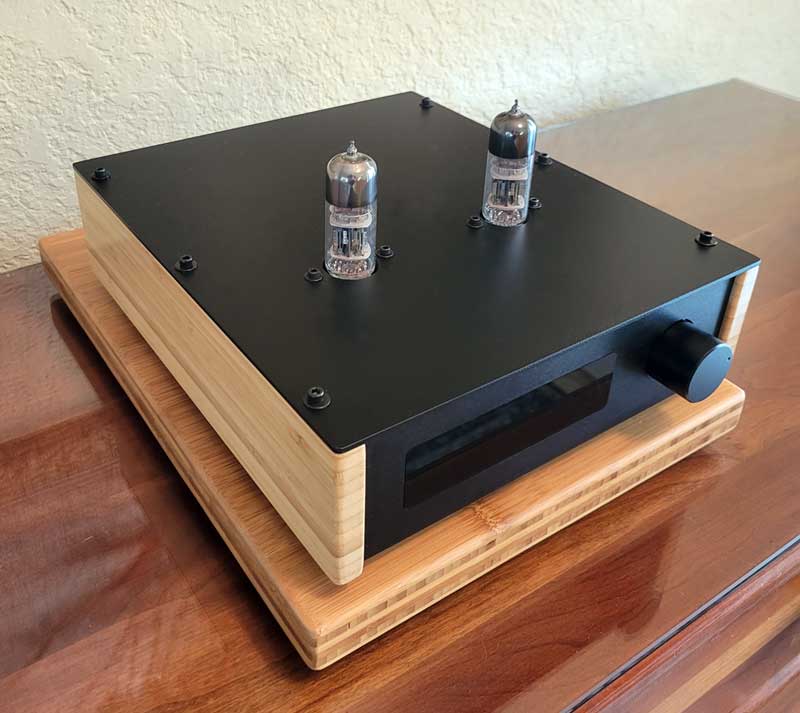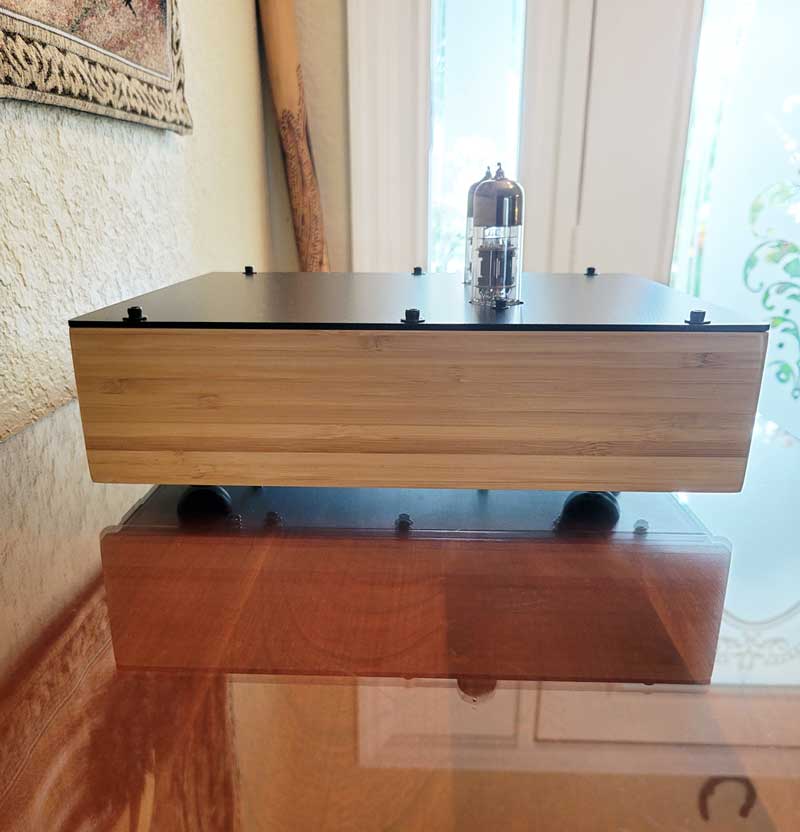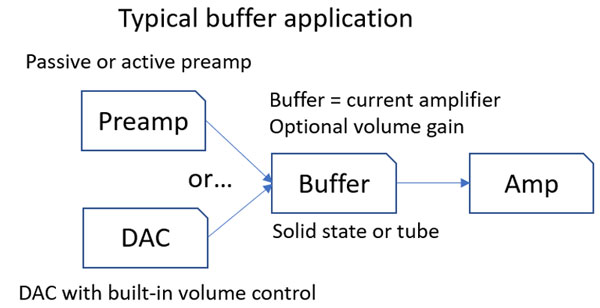TPB.V3 Tube Buffer
Price range: $1,495.00 through $1,695.00
The TPB.V3 is a high performance hybrid buffer that combines a tube input stage with a solid-state JFET output stage to deliver robust dynamic sound with just the right amount of tube euphonics to breath new life into your music and your existing audio gear. Don’t be surprised if you find yourself enjoying your music collection all over again…and again!
The TPB.V3 is an ideal addition to both passive (Tortuga Audio LDR passives) and active preamps as well as any DAC or other audio source with its own volume control. The TPB.V3 comes in both single-ended (RCA) and balanced (XLR) models.
This buffer is built to order so please allow 5-10 days from order to ship date.
Why use a tube buffer?
A great tube buffer delivers robust dynamics with just the right touch of that sparkling airy sound that only tubes can deliver. A great tube buffer can be a wonderful addition to your system.
Improves sound quality – This is job #1 of any buffer. If a buffer doesn’t make your existing system sound better (more fun to listen to) then either you already have a great system (congrats!) or … you need to get a better buffer!
Adds more authority and punch to your system’s dynamics – A buffer’s main job is to be a power/current amplifier. A buffer doesn’t make music louder. It makes music sound bolder, more dynamic, and with greater authority.
Add some beautiful tube harmonics – Call it euphonics, call is harmonics or call it distortion, the fact is tubes deliver a low level of second order harmonics that most people find musical and pleasing to the ear.
Sand that digital edge off your DAC – Even the best digital sources and DACs are usually solid state designs that too often come across a bit dry or even harsh at times. A good tube buffer can mitigate this with little or no downsides.
Use your passive preamp with long cable runs – If you love your passive preamp but need to run longer cables to you amp, adding a buffer between your passive preamp and amp eliminates the cable length constraint.
Eliminate impedance mismatches between components – Adding a buffer between any two components creates an electronic firewall that makes any impedance mismatch problem moot.
Drive a subwoofer amp from your passive preamp – If you love your passive preamp but find it can’t drive both a main and subwoofer amp, a buffer will resolve this.
What is a buffer?
Most preamps, and all power amps, provide voltage amplification (or “gain”). Increasing the voltage level of an audio signal is synonymous with increasing its volume. Buffers typically do not provide voltage amplification. Instead, buffers provide current amplification.
Current amplification helps deliver the audio signal (the voltage waveform) with optimal power, coherence and dynamic authority. As a result, strings have more attack when plucked, drums have more visceral punch, and all transients are generally better defined and detailed. Buffers also act as an electronic firewall between your source and your amp by presenting a high input impedance to the upstream source and a low output impedance to the downstream amp.
Compared to a typical active preamplifier, a buffer has no volume control, no input switching, and, as previously stated, usually has no gain (voltage/volume amplification).
Buffers can be solid state or tube. Some can be a hybrid with a tube input stage and a solid state output stage. Tortuga Audio’s TPB.V3 Tube Preamp Buffer is a hybrid buffer.
The TPB.V3 | how it works
A hybrid tube & solid state buffer – Conventional buffers typically have only an output stage. The TPB.V3 is a hybrid stereo tube buffer that combines a tube input stage with a solid state JFET (transistor) output stage as shown below in the simplified schematic of a single channel.
Two 6H30 triode tubes – We chose the 9-pin 6H30Pi Gold triode tube from Electro-Harmonix as our default because of its growing reputation for sonic excellence, robust long-life, and the fact that it’s a contemporary tube that isn’t likely to go out of production for a long time to come. Two 6H30 tubes are used to provide a dedicated 2 channel tube for each stereo channel to ensure optimal channel separation and stereo imaging. Balanced models use both channels of each tube while the single-ended model only uses one channel in each tube.
Direct coupled input – The buffer input is direct coupled to the grid of the triode tube. There are no input transformers or input coupling capacitors to degrade sound quality. Output from the tube stage goes directly into the JFET current amplifier (i.e. the buffer proper) which runs as a constant current class A buffer/output stage. An output coupling capacitor blocks DC offset.
Optional gain if you need it – The TPB.V3 is configured by default as a unity gain buffer, i.e. no volume amplification . The reason for this is quite simple. Most home audio stereo systems do not require signal amplification by a preamp/buffer in order to achieve sufficient volume levels. And since all amplification increases signal noise, why amplify any more than is necessary? For those systems that need a little more volume headroom, the gain of TPB.V3 tube buffer can be increased by the user by swapping out the unity gain plug-in gain modules with higher gain plug-in modules of +3 dB (1.414 x gain) or +6 dB (2.0 x gain).
Solid state output stage – The output stage of the TPB.V3 employs the highly regarded, low noise, LSK170 JFET transistor in an elegantly simple class A constant current circuit with commensurate low output impedance. The result does not disappoint. The JFET acts as a current amplifier (a.k.a. “current drive”). Unlike a voltage amplifier (voltage gain stage) which makes music louder, a current amplifier delivers the music with more authority, power and dynamics. To use the garden hose analogy, if music volume is water pressure, then current drive is the capacity to deliver the water flow. That’s the job of the audio buffer; to effectively deliver the content of the audio signal represented by the voltage. The single-ended model has 2 JFET output buffers (1 for each stereo channel) while the balanced model has 4 JFET output buffers (2 for each stereo channel).
Hybrid switching/linear power supply – The TPB.V3 uses a robust. oversized 40 watt AC-DC switch mode power supply that accepts any level of AC mains input from 85-265 VAC to produced rectified 12 V DC power. DC power is then run through a simple linear filter into 2 separate DC-DC converters. One is dedicated to providing the 6.3 VDC tube heater current. The second DC-DC converter boosts the voltage to 30 VDC that is then run through both a linear filter followed by a dedicated linear regulator to deliver clean tube power and constant Class A current to the JFET buffer.
Two models | single-ended RCA & balanced XLR
The TPB.V3 Tube Preamp Buffer comes in two models; a single-ended buffer for RCA interconnects, and a balanced buffer for balanced XLR interconnects. Dual parallel outputs are standard in each model making it easy to biamp or drive both a main amp and a sub amp.
Tube rolling possibilities
Tube rollers will be pleased to note that the TBP.V3 allows you to substitute the stock 6H30 tube with any tube from the 6DJ8 / ECC88 / 6922 / 7308 family of tubes which opens up a big wide world of tube rolling possibilities. These alternative tubes often deliver a more lush tube sound than the more neutral stock 6H30. More info on tube rolling the buffer can be found here.
Upgrading output coupling capacitors
Since the TPB.V3 relies on an output coupling capacitor to pass through the audio signal, the performance of that capacitor becomes the ultimate limiting factor in performance. We employ a good yet modest stock polypropylene output coupling capacitor that can be upgraded to either an excellent high performance V-Cap ODAM (oil damped advanced metallized) capacitor or the quite pricey V-Cap CuTF (copper foil fluoropolymer film) capacitor for those seeking the ultimate in performance.
Two coupling capacitors are used in the single-ended model and four are used in the balanced model.
Specifications
These specifications reasonably reflect the current model and are subject to updating and modification without notification.
(coming soon)
| Model type | Single-Ended, Balanced |
|---|




